
The TGV is France's intercity high-speed rail service, operated mainly by SNCF. SNCF worked on a high-speed rail network from 1966 to 1974 and presented the project to President Georges Pompidou who approved it. Originally designed as turbotrains to be powered by gas turbines, TGV prototypes evolved into electric trains with the 1973 oil crisis. In 1976 the SNCF ordered 87 high-speed trains from Alstom. Following the inaugural service between Paris and Lyon in 1981 on the LGV Sud-Est, the network, centred on Paris, has expanded to connect major cities across France and in neighbouring countries on a combination of high-speed and conventional lines. The TGV network in France carries about 110 million passengers a year.

Thalys was a brand name used for high-speed train services between Paris Gare du Nord via Brussels-South to either Amsterdam Centraal or to German cities in the Rhein-Ruhr, including Aachen, Cologne, Düsseldorf, Duisburg, Essen and Dortmund. Since 29 September 2023, the services operate under the Eurostar name; sometimes referred to as Eurostar Red, based on the colour of the trains.

The Société nationale des chemins de fer français is France's national state-owned railway company. Founded in 1938, it operates the country's national rail traffic along with that of Monaco, including the TGV, on France's high-speed rail network. Its functions include operation of railway services for passengers and freight, as well as maintenance and signalling of rail infrastructure. The railway network consists of about 35,000 km (22,000 mi) of route, of which 2,600 km (1,600 mi) are high-speed lines and 14,500 km (9,000 mi) electrified. About 14,000 trains are operated daily.

The SNCF TGV Réseau (TGV-R) is a TGV train built by Alstom between 1992 and 1996 for SNCF, the French national railway for use on high-speed TGV services. The Réseau trainsets are based on the earlier TGV Atlantique. The first Réseau sets entered service in 1993.
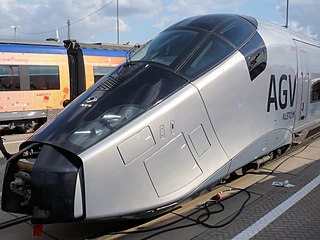
The AGV is a standard gauge, high-speed, electric multiple-unit train designed and built by Alstom.

The SNCF TGV Sud-Est was a French high speed TGV train built by Alstom and Francorail-MTE and operated by SNCF, the French national railway company. A total of 111 trainsets were built between 1978 and 1988 for the first TGV service in France between Paris and Lyon which opened in 1981. The trainsets were semi-permanently coupled, consisting of two power cars (locomotives) and eight articulated passenger carriages, ten in the case of the tri-voltage sets. The trains were named after the Ligne à Grande Vitesse Sud-Est that they first operated on. They were also referred to as TGV-PSE, an abbreviation of Paris Sud-Est.

The TGV POS is a TGV train built by French manufacturer Alstom which is operated by the French national rail company, the SNCF, in France's high-speed rail lines. It was originally ordered by the SNCF for use on the LGV Est, which was put into service in 2007. POS is an abbreviation of Paris-Ostfrankreich-Süddeutschland, the route of the LGV Est.

The TGV Duplex is a French high-speed train of the TGV family, manufactured by Alstom, and operated by the French national railway company SNCF. They were the first TGV trainsets to use bi-level passenger carriages with a seating capacity of 508 passengers, increasing capacity on busy high-speed lines. While the TGV Duplex started as a small component of the TGV fleet, it has become one of the system's workhorses.
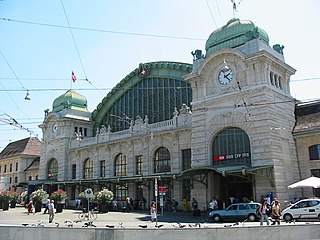
Basel SBB railway station is the central railway station in the city of Basel, Switzerland. Opened in 1854, and completely rebuilt in 1900–1907, it is Europe's busiest international border station. Basel SBB is owned by the Swiss Federal Railways (SBB CFF FFS). The other major railway station is Basel Badischer Bahnhof, operated by the German railway company Deutsche Bahn, on the north side of the Rhine from the city centre.
SNCF Connect, formerly OUI.sncf until January 25, 2022, is a subsidiary of SNCF selling passes and point-to-point tickets for rail travel around Europe. It has commercial links to major European rail operators including SNCF, Eurostar, Deutsche Bahn, and Thalys, and is made up of four independent companies in distinct geographical areas. As at 2003, It was the largest French electronic commerce website in volume. One quarter of French SNCF tickets are sold by this website.
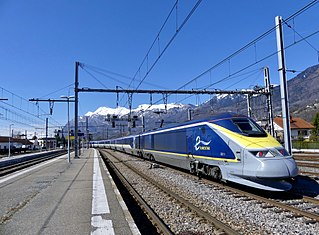
The British Rail Class 373, known in France as the TGV TMST and branded by Eurostar as the Eurostar e300, is a French designed and Anglo-French built electric multiple unit train that was used for Eurostar international high-speed rail services from the United Kingdom to France and Belgium through the Channel Tunnel. Part of the TGV family, it was built with a smaller cross-section to fit the smaller loading gauge in Britain, was originally capable of operating on the UK third rail network, and has extensive fireproofing in case of fire in the tunnel. It is both the second longest—387 metres —and second fastest train in regular UK passenger service, operating at speeds of up to 300 kilometres per hour (186 mph).
Trenitalia France is an open-access train operator running international services between France and Italy. It was originally established under the Thello brand in October 2011.
The France Rail Pass was a railway ticket available until December 2018 for non-European residents provided by the Société Nationale des Chemins de fer Français (SNCF), or French railway. The France Rail Pass provided unlimited travel for non-European residents on the national rail network of France. The pass provided unlimited three to nine days of unlimited rail travel within one month. The France Rail Pass is a SNCF Voyages et Développement product for the SNCF company.
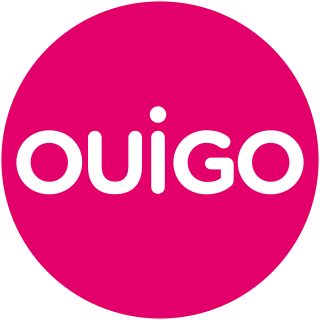
Ouigo is a French low-cost service range of both conventional and high-speed trains. The literal translation of Ouigo from French to English is "yes go"; the name is also a play on words with the English homonym "we go." It is composed of two different services: Ouigo Grande Vitesse, which is a brand of SNCF operating high-speed trains; and Ouigo Vitesse Classique, a brand under which Oslo, a subsidiary of SNCF, operates conventional speed trains.
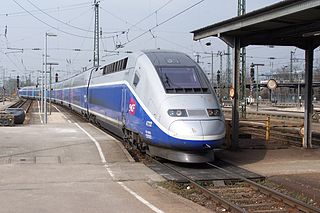
Avelia Euroduplex, more commonly known as just Euroduplex or TGV 2N2 in France, is a high-speed double-decker train manufactured by Alstom. It is primarily operated by the French national railway company SNCF, and also in operation with the Moroccan national railway company ONCF. It is the 3rd generation of the TGV Duplex.
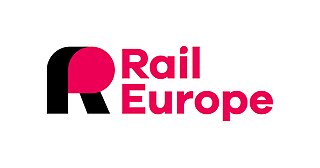
Rail Europe, SAS is a company that specializes in providing train tickets and rail passes for travel in Europe.
Raileurope.co.uk is an online booking service for train travel in the United Kingdom and Europe. It sells tickets through its website and via its smartphone app which is available on iOS and Android platforms.
Trainline Europe is the European arm of Trainline, Europe's leading train and coach app. Through either its web interface or mobile apps, customers can purchase tickets for a variety of European rail operators. It also has loyalty cards or vouchers and with e-ticket support. In 2016, Captain Train was acquired by Trainline.

Izy was a low-cost train service between Brussels and Paris. Services started on 3 April 2016, and ended on 10 July 2022.

The TGV M is a high-speed passenger train designed and produced by Alstom. It has a broadly similar design to the TGV Duplex sets, with bi-level carriages and a push–pull configuration with a power car on either end. However, it is more energy efficient and provides lower operating costs.















